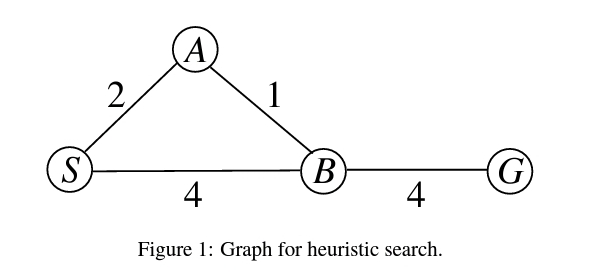Please answer the following question in full detail. Please be specifix about everything: You have learned before that A∗ using graph search is optimal if h(n) is consistent. Does this optimality still hold if h(n) is admissible but inconsistent? Using the graph in Figure 1, let us now show that A∗ using graph search returns the non-optimal solution path (S,B,G) from start node S to goal node G with an admissible but inconsistent h(n). We assume that h(G) = 0. Give nonnegative integer values for h(A) and h(B) such that A∗ using graph search returns the non-optimal solution path (S,B,G) from S to G with an admissible but inconsistent h(n), and tie-breaking is not needed in A∗.
Please answer the following question in full detail. Please be specifix about everything:
You have learned before that A∗ using graph search is optimal if h(n) is consistent. Does this optimality still hold if h(n) is admissible but inconsistent? Using the graph in Figure 1, let us now show that A∗ using graph search returns the non-optimal solution path (S,B,G) from start node S to goal node G with an admissible but inconsistent h(n). We assume that h(G) = 0. Give nonnegative integer values for h(A) and h(B) such that A∗ using graph search returns the non-optimal solution path (S,B,G) from S to G with an admissible but inconsistent h(n), and tie-breaking is not needed in A∗.

Trending now
This is a popular solution!
Step by step
Solved in 2 steps

I meant to say that S -> A -> B -> G is the actual optimal path with cost 7 compared to S -> B -> G which has a path cost of 8. But with the heuristics considered this would be the search:
S -> A = 2 + h(A) = 3
S -> B = 4 + h(B) = 7
From there on, it would lead to S -> A -> B -> G and not S -> B -> G, which is we want to have in this problem. So how is this solved? Since S -> A -> G isn't optimal as it is not possible to reach G without intercepting B.
Sorry for the typo earlier.
Isn't the actual optimal S->B->G. If yes, then how are the assumed heuristics valid?








